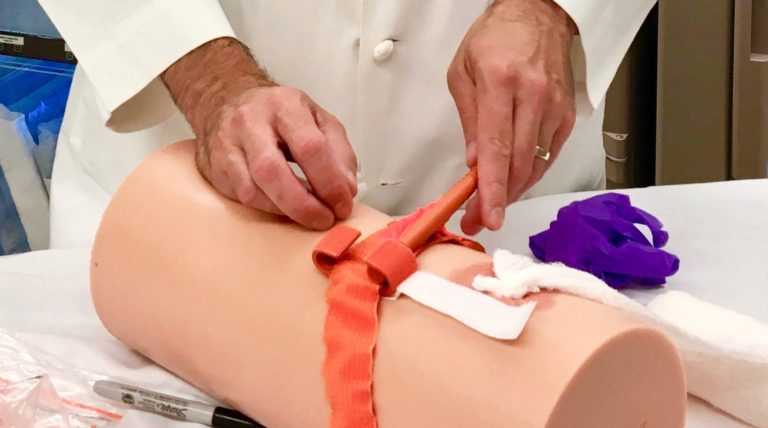Although several studies have looked at tourniquet use in civilian settings, the survival benefit for patients was unclear. However, new research from Texas shows that for civilian patients with peripheral vascular injury, prehospital tourniquet use is associated with dramatically improved odds of survival.
The new study — Civilian Prehospital Tourniquet Use Is Associated with Improved Survival in Patients with Peripheral Vascular Injury — was recently published as an article in press by the Journal of the American College of Surgeons.
For the study, the Texas Tourniquet Study Group evaluated 1,026 patients with vascular injuries of the arms or legs admitted to 11 urban Level I trauma centers in Texas from 2011 to 2016. A prehospital tourniquet was used in 17.6 percent of the cases, although tourniquet use varied widely among individual centers, ranging from 62 percent to 1.4 percent.
Average tourniquet time for these patients was about 77 minutes. After multivariable analysis, the non-tourniquet group had almost six times greater odds of death than the group of patients who received a tourniquet (adjusted odds ratio: 5.86).
“This is the first time that we were actually able to prove the survival benefit of using the tourniquet in the civilian population,” said lead study author Pedro Teixeira, MD, FACS, of the University of Texas at Austin, Dell Medical School.
Overall, 9.6 percent of the study patients had amputations, and more than one-third of those patients had received a tourniquet. However, amputation patients who received a tourniquet had significantly lower mortality rates than those who did not — 2.9 percent vs. 7.9 percent.
Tourniquets work best when they are applied as early as possible at the site of the injury, Dr. Teixeira noted. “The ideal person to apply that tourniquet is the person who can do it the quickest immediately after the wound is identified,” he said. “That scenario is the highest chance for the patient to survive.”
(For more information on using tourniquets effectively, read Stop the Bleed: 8 pitfalls to avoid in hemorrhage control.)
While there is a cost involved in having tourniquets available for general use, the Texas Tourniquet Study Group research may help justify that cost, according to an American College of Surgeons press release.
“Being able to demonstrate that tourniquets actually do the job they’re supposed to do is important and supports the recommendations by the Stop the Bleed campaign, contributing to reducing mortality from bleeding on the streets of America and elsewhere,” Dr. Teixeira said.
The study results were first presented in September 2017 at the 76th annual meeting of the American Association for the Surgery of Trauma and Clinical Congress of Acute Care Surgery in Baltimore.


6 Comments
Very interesting but does not cover a very important aspect of their (tourniquet) use, the legal problems with non-docs applying them in the field, even if the person applying it is a doc the legal down side is enormous. If the victim loses a leg or arm even if non-application would have resulted in death the lawsuits are a given and in to days courts the person applying it are very very likely to lose the suit and their lives to the law suits. Unless the state where this takes place covers application in their good Samaritan laws specifically you have to think long and hard about using one and not just falling back on pressure applications unless it’s a member of family or other person too whom you have a connection.
I think that you need to read more about tourniquets and the length of time before damage. The tourniquet has saved countless lives on the battlefield and even makeshift tourniquets as well as commercial tourniquets have saved lives in the civilian setting. In a situation like these many school shootings and other event shootings, the first responder is the person next to you. The goal is to save lives. The tourniquet is temporary and the physician would remove it upon arrival to the hospital after assessment with means such as surgery or other medical options as deemed by the medical team. You should check out the national Stop the Bleed program where healthcare personnel as well as lay persons are taught the proper use of tourniquets.
Regarding the “legal problems”, no one can guarantee that a person will survive injuries sustained. If understanding the implications mentioned, a suit would be related to the tourniquet application. Realize that a person may have already lost too much blood before the tourniquet could be applied. The person may have sustained even more life-threatening injuries that took the person’s life. Ask how many soldiers and even civilians who are not physicians would gladly place a tourniquet again to save a life. The potential for a lawsuit does not seem so likely to me. It is understandable that initially the grief of losing a person may invoke a sense to correct the problem with a lawsuit. I have not seen a study regarding the number of lawsuits for tourniquet placement when the victim did not survive, nor have I read of such suits being brought against the “first responders”. If I see a person who is bleeding from an injury or needs that bleeding stopped to save the person’s life, I would apply a tourniquet if appropriate or a pressure dressing to save that person.
Sulaco, you literally could not be more wrong and you have zero facts to support your opinion. Please show me just one case in which a person was successfully sued for applying a tourniquet and saving someone’s life.
Pingback: Misfires And Light Strikes
Pingback: A Smaller Blow-Out Kit for Smaller People – Home Hardening